Mind the cap!
By Steve Schaeber, MACS manager of Service Training
Radiator caps play an important role in engine cooling systems, sometimes more important than you may think. It might appear they are simply an access point to open and close the system (and keep coolant inside), but actually, they work hard behind the scenes to help regulate system pressure (and temperature, too). Some also meter coolant to an overflow bottle to maintain fill level.
Most engine cooling systems are closed systems, meaning that once they are filled and the cap is on, they are effectively sealed off from the outside. As engine temperature increases from a cold start, the temperature (and pressure of the coolant within this closed system) also increases. Normally the system regulates temperature somewhere around 195°F. However, during a normal drive cycle, engine load increases and decreases as driving conditions change. Sometimes load is low, such as when idling or cruising along a straight and level road. Other times it’s high, while driving uphill, towing a trailer, or during stop-and-go city traffic. These variations make the engine work harder to meet demand.
This is when the radiator cap shines, allowing the system to build pressure (usually up to around 15 psi) so coolant temperature can increase without boiling. In fact, for each psi of pressure that is added to the system, the boiling point of coolant is increased by about 3°F. Therefore, at a working pressure of around 15 psi, the boiling point of coolant is about 267°F (boiling point of water 212°F + 45°F = 267°F). It’s because of this increase in pressure that the cooling system is able to function without boiling over.
As pressure reaches the rating listed on the cap, a valve within the cap opens slightly, allowing excess pressure (and coolant) to bleed off into an overflow tank. Also, if there’s any air bubbles in the system, they too will bleed off as they reach the cap. If the cap vent fails, excess coolant pressure could cause a hose to burst, connection to break or worse, a radiator or heater core could rupture. Consequently, as the system cools back down, temperature and pressure decrease, and a slight vacuum is created in the system. The radiator cap goes to work here, as well; it has a vacuum valve that opens, allowing excess coolant in the overflow to be sucked back into the radiator. If this vacuum valve fails, a hose may collapse or worse, the radiator itself could fail.
Radiator caps are tested using a pressure tester and specific adapter. Pressure should be able to build up to the cap’s
rating without decay. A cap not able to hold pressure (or one that quickly bleeds off) should be replaced. Also be sure to inspect gaskets and sealing surfaces. Vehicles with a bad radiator cap may not overheat at idle yet may quickly overheat under load or highway driving conditions.
Two SAE Standards apply to radiator caps: SAE J164, “Radiator Caps and Filler Necks,” details nominal size, dimensions and pressure ratings of various caps, and; SAE J151, “Pressure Relief for Cooling System,” describes how a radiator cap should be opened in order to safely release pressure from the system while also requiring pressure rating information on the cap.
Learn more about MACS at www.macsw.org


Leave a Reply